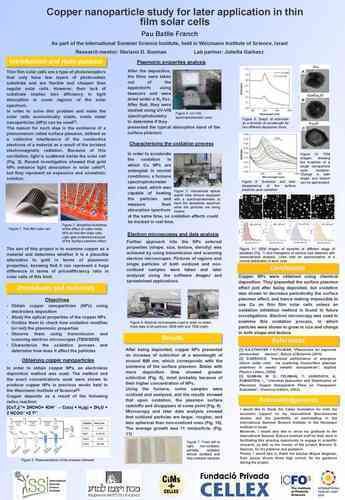Copper nanoparticle study for later application in thin film solar cells
pau batlle franch
institut jaume vicens vives – girona
Thin film solar cells are photoreceptors with low substrate quantity and low cost in comparison to regular cells. Nevertheless, they have not been an alternative to common solar cells since their light absorption rate is poor.
One of the possible solutions for this is the usage of noble metal nanoparticles (NPs), which present a common excitation of its electrons called surface plasmon. It implies an increase of light scattering at certain wavelengths, and it can be used to rise solar cells’ efficiency by adding these NPs on the cell’s surface. Indeed, in external former studies, the usage of gold NPs lead to positive results.
Knowing that copper presents similar properties to gold and that it would represent a cheaper alternative, the main aim of this project was determining whether copper is a feasible alternative to gold.
Experimentation showed that copper NPs presented appropriate properties, since the surface plasmon rise in scattering was observed at around 600 nm. Notwithstanding, NPs are easily oxidized, preventing them from maintaining such properties. The surface plasmon redshifted and later disappeared upon oxidation. Therefore, oxidation is a disadvantage prior to using copper NPs in solar cells.
Additionally, using spectrophotometry and electron microscopy, information regarding oxidation was gathered, which was later used to characterise the changes in Nps. Oxidized particles appeared to be rougher and less spherical than nonoxidized ones, as well as having an increase in radius of about 11 nm on average.
The main conclusion obtained was that oxidation is an impediment for using copper nanoparticles in thin film solar cells. It is believed that copper will represent an alternative to gold once oxidation inhibition methods are found, although efficient techniques have not been discovered yet. If they were found, we would definitely much closer to cheaper and more efficient solar cells.


